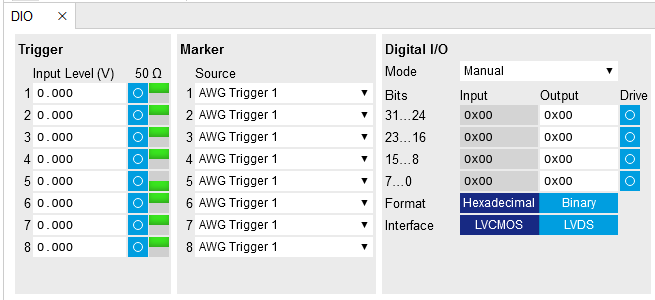DIO Tab¶
The DIO tab provides access to the settings and controls of the digital inputs and outputs. It is available on all SHFSG+ Instruments.
Features¶
- Monitor and control of 32-bit DIO port
- Configure Trigger Inputs and Marker Outputs
- Configure the Internal Trigger settings
Description¶
The DIO tab is the main panel to control the digital inputs and outputs as well as the trigger levels. Whenever the tab is closed or an additional one of the same type is needed, clicking the following icon will open a new instance of the tab.

The Digital I/O section provides numerical monitors to observe the states of the digital inputs and outputs. Moreover, with the values set in the Output column and the Drive button activated the states can also be actively set in different numerical formats. The Trigger section shows the settings for the 4 or 8 Trig inputs on the front panel. The LED status indicator helps in monitoring the input signal state and selecting the threshold. The Marker section allows users to assign internal marker bits to the 4 or 8 Mark outputs on the front panel. Alternatively, the outputs can be set to static high or low values. In the System Settings section, the number of repetitions and the holdoff time of the Internal Trigger can be configured. The Internal Trigger is useful for synchronizing the outputs of different channels on the same instrument. The marker outputs have a configurable delay, with a resolution of 1 ns.
Digital I/O¶
The Digital I/O has 3 operation modes: Manual means controlled manually, QA Sequencer n means controlled by QA Sequencer n, QA there are the 32-bit DIO port is in use.
Figure 2 shows the architecture of the DIO port. It features 32 bits that can be configured byte-wise as inputs or outputs by means of a drive signal. The digital output data is latched synchronously with the falling edge of the internal clock, which is running at 50 MHz. The internal sampling clock is available at the DOL pin of the DIO connector. Digital input data can either be sampled by the internal clock or by an external clock provided through the CLKI pin. A decimated version of the input clock is used to sample the input data. The Decimation unit counts the clocks to decimation and then latches the input data. The default decimation is 5625000, corresponding to a digital input sampling rate of 1 sample per second.

In Manual mode, each DIO pin can be controlled manually according to Figure 2 and the DIO interface specification is detailed in Specifications.
ZSync Interface¶
The ZSync link of the Zurich Instruments' Quantum Computing Control System (QCCS) enables Instrument synchronization and communication on the system level through the Zurich Instruments' PQSC Programmable Quantum System Controller. This architecture is able to support quantum algorithms run in scalable quantum processors.
In particular, the ZSync links distribute the system clock to all Instruments and synchronize all Instruments to sub-nanosecond levels. Besides status monitoring to ensure quality and reliability of qubit tune-up routines, it provides a bidirectional data interface to send readout results to, or obtain sequence instructions from the PQSC.
The ZSync links adhere to strict real-time behavior: all data transfers are predictable to single clock cycle precision. In the SHFSG+, the link is optimized for maximum data transfer bandwidth to the central controller. For example, twice the bandwidth is reserved for results being transferred to the PQSC with respect to the allocated bandwidth for instructions that are received from the PQSC. This enables global feedback and error correction through centralized syndrome decoding and synchronized actions on the global QCCS system level.
Feedback through the PQSC¶
Note
More information on the ZSync, and how to properly link the SHFSG+ with the QCCS can be found in the user manual of the PQSC Programmable Quantum System Controller.
Using the startQA- command, the SHFQA+ or the Quantum Analyzer Channel
of the SHFQC+ generates a readout result and forwards it to the PQSC over
the ZSync. Depending on the address provided, the PQSC stores it in the
register bank - the center of the feedback in the QCCS system. After
processing, the PQSC then forwards the results to other devices in the
QCCS, such as the SHFSG+.
The register bank requires a readout to have an address and a mask along with the readout data. Each component is sent in a separate ZSync message. The address is sent first, followed by the mask, and then the data, see Figure 3. To reduce latency, the address and the mask are sent during the readout, and the data is then sent as soon as the discriminated qubit results are ready.

